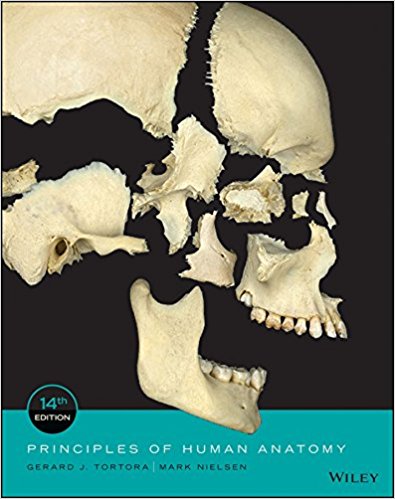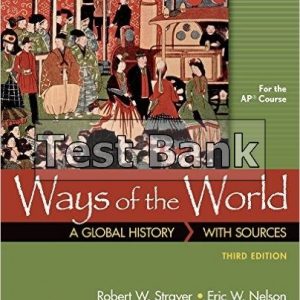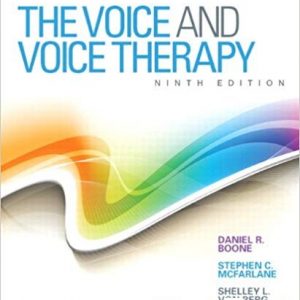This is completed downloadable of Test Bank for Principles of Human Anatomy 14th by Tortora

Product Details:
- ISBN-10 : 1119444462
- ISBN-13 : 978-1119444466
- Author: Tortora
Immerse yourself in the spectacular visuals and dynamic content of Principles of Human Anatomy, 14th Edition. Designed for the 1-term Human Anatomy course, this 14th edition raises the standard for excellence in this discipline with its enhanced illustration program, refined narrative, and dynamic resources. Principles of Human Anatomy is a rich digital experience, giving students the ability to learn and explore human anatomy both inside and outside of the classroom.
Table of Content:
- 1 AN INTRODUCTION TO THE HUMAN BODY
- 1.1 Anatomy Defined
- 1.2 Levels of Body Organization and Body Systems
- 1.3 Life Processes
- 1.4 Basic Anatomical Terminology
- Anatomical Position
- Regional Names
- Planes and Sections
- 1.5 Body Cavities
- Thoracic and Abdominal Cavity Membranes
- 1.6 Abdominopelvic Regions and Quadrants
- 1.7 The Human Body and Disease
- 1.8 Aging
- 1.9 Medical Imaging
- 1.10 Measuring the Human Body
- Chapter Review and Resource Summary
- Critical Thinking Questions
- Answers to Figure Questions
- 2 CELLS
- 2.1 A Generalized Cell
- 2.2 The Plasma Membrane
- Structure of the Membrane
- Functions of Membrane Proteins
- Membrane Permeability
- Transport Across the Plasma Membrane
- Kinetic Energy Transport
- Transport by Transporter Proteins
- Transport in Vesicles
- 2.3 Cytoplasm
- Cytosol
- Organelles
- Centrosome
- Cilia and Flagella
- Ribosomes
- Endoplasmic Reticulum (ER)
- Golgi Complex
- Lysosomes
- Peroxisomes
- Proteasomes
- Mitochondria
- 2.4 Nucleus
- 2.5 Cell Division
- Somatic Cell Division
- Interphase
- Mitotic Phase
- Control of Cell Destiny
- Reproductive Cell Division
- Meiosis
- 2.6 Cellular Diversity
- 2.7 Aging and Cells
- Key Medical Terms Associated with Cells
- Chapter Review and Resource Summary
- Critical Thinking Questions
- Answers to Figure Questions
- 3 TISSUES
- 3.1 Types of Tissues
- 3.2 Cell Junctions
- Tight Junctions
- Adherens Junctions
- Desmosomes
- Hemidesmosomes
- Gap Junctions
- 3.3 Comparison Between Epithelial and Connective Tissues
- 3.4 Epithelial Tissue
- Classification of Surface Epithelium
- Surface Epithelium
- Glandular Epithelium
- Structural Classification of Exocrine Glands
- Functional Classification of Exocrine Glands
- 3.5 Connective Tissue
- General Features of Connective Tissue
- Connective Tissue Cells
- Connective Tissue Extracellular Matrix
- Ground Substance
- Fibers
- Classification of Connective Tissue
- Embryonic Connective Tissue
- Mature Connective Tissue
- Connective Tissue Proper
- Supporting Connective Tissue
- Liquid Connective Tissue
- 3.6 Membranes
- Epithelial Membranes
- Mucous Membranes
- Serous Membranes
- Cutaneous Membrane
- Synovial Membranes
- 3.7 Muscular Tissue
- 3.8 Nervous Tissue
- 3.9 Aging and Tissues
- Key Medical Terms Associated with Tissues
- Chapter Review and Resource Summary
- Critical Thinking Questions
- Answers to Figure Questions
- 4 DEVELOPMENT
- 4.1 Principles of Development
- 4.2 Embryonic Period
- First Week of Development
- Fertilization
- Cleavage of the Zygote
- Blastocyst Formation
- Implantation
- Second Week of Development
- Development of the Trophoblast
- Development of the Bilaminar Embryonic Disc
- Development of the Amnion
- Development of the Yolk Sac
- Development of Sinusoids
- Development of the Extraembryonic Coelom
- Development of the Chorion
- Third Week of Development
- Gastrulation
- Neurulation
- Development of Somites
- Development of the Intraembryonic Coelom
- Development of the Cardiovascular System
- Development of the Chorionic Villi and Placenta
- Fourth Week of Development
- Fifth Through Eighth Weeks of Development
- 4.3 Fetal Period
- 4.4 Maternal Changes During Pregnancy
- 4.5 Labor
- Key Medical Terms Associated with Development
- Chapter Review and Resource Summary
- Critical Thinking Questions
- Answers to Figure Questions
- 5 THE INTEGUMENTARY SYSTEM
- 5.1 Structure of the Skin
- Epidermis
- Stratum Basale
- Stratum Spinosum
- Stratum Granulosum
- Stratum Lucidum
- Stratum Corneum
- Keratinization and Growth of the Epidermis
- Dermis
- Blood Supply of the Integumentary System
- The Structural Basis of Skin Color
- Tattooing and Body Piercing
- Subcutaneous Layer or Hypodermis
- 5.2 Accessory Structures of the Skin
- Hair
- Anatomy of a Hair
- Hair Growth
- Types of Hairs
- Hair Color
- Skin Glands
- Sebaceous Glands
- Sudoriferous Glands
- Ceruminous Glands
- Nails
- 5.3 Types of Skin
- 5.4 Functions of the Skin
- 5.5 Development of the Integumentary System
- 5.6 Aging and the Integumentary System
- Key Medical Terms Associated with the Integumentary System
- Chapter Review and Resource Summary
- Critical Thinking Questions
- Answers to Figure Questions
- 6 BONE TISSUE
- 6.1 Functions of Bone and the Skeletal System
- 6.2 Types of Bones
- 6.3 Anatomy of a Bone
- 6.4 Bone Surface Markings
- 6.5 Histology of Bone Tissue
- Compact Bone Tissue
- Spongy Bone Tissue
- 6.6 Blood and Nerve Supply of Bone
- 6.7 Bone Formation
- Initial Bone Formation in an Embryo and Fetus
- Intramembranous Ossification
- Endochondral Ossification
- Bone Growth During Infancy, Childhood, and Adolescence
- Growth in Length
- Growth in Thickness
- Remodeling of Bone
- 6.8 Fractures
- 6.9 Exercise and Bone Tissue
- 6.10 Aging and Bone Tissue
- 6.11 Factors Affecting Bone Growth
- Key Medical Terms Associated with Bone Tissue
- Chapter Review and Resource Summary
- Critical Thinking Questions
- Answers to Figure Questions
- 7 THE SKELETAL SYSTEM: THE AXIAL SKELETON
- 7.1 Divisions of the Skeletal System
- 7.2 Skull
- General Features and Functions
- Nasal Septum
- Orbits
- Foramina
- Unique Features of the Skull
- Sutures
- Paranasal Sinuses
- Fontanels
- Cranial Fossae
- Age-related Changes in the Skull
- Sexual Differences in the Skull
- 7.3 Hyoid Bone
- 7.4 Vertebral Column
- Normal Curves of the Vertebral Column
- Intervertebral Discs
- Parts of a Typical Vertebra
- Vertebral Body
- Vertebral Arch
- Processes
- Regions of the Vertebral Column
- Age-related Changes in the Vertebral Column
- 7.5 Thorax
- Key Medical Terms Associated with the Axial Skeleton
- Chapter Review and Resource Summary
- Critical Thinking Questions
- Answers to Figure Questions
- 8 THE SKELETAL SYSTEM: THE APPENDICULAR SKELETON
- 8.1 Skeleton of the Upper Limb
- 8.2 Skeleton of the Lower Limb
- 8.3 False and True Pelves
- 8.4 Comparison of Female and Male Pelves
- 8.5 Comparison of Pectoral and Pelvic Girdles
- 8.6 Development of the Skeletal System
- Key Medical Terms Associated with Appendicular Skeleton
- Chapter Review and Resource Summary
- Critical Thinking Questions
- Answers to Figure Questions
- 9 JOINTS
- 9.1 Joint Classifications
- Ligaments
- 9.2 Fibrous Joints
- Sutures
- Syndesmoses
- Interosseous Membranes
- 9.3 Cartilaginous Joints
- Synchondroses
- Symphyses
- Epiphyseal Cartilages
- 9.4 Synovial Joints
- Structure of Synovial Joints
- Articular Capsule
- Synovial Fluid
- Accessory Ligaments, Articular Discs, and Labra
- Nerve and Blood Supply
- Bursae and Tendon Sheaths
- 9.5 Types of Movements at Synovial Joints
- Gliding
- Angular Movements
- Flexion, Extension, Lateral Flexion, and Hyperextension
- Abduction, Adduction, and Circumduction
- Rotation
- Special Movements
- 9.6 Types of Synovial Joints
- Plane Joints
- Hinge Joints
- Pivot Joints
- Condyloid Joints
- Saddle Joints
- Ball-and-Socket Joints
- 9.7 Factors Affecting Contact and Range of Motion at Synovial Joints
- 9.8 Selected Joints of the Body
- 9.9 Aging and Joints
- Key Medical Terms Associated with Joints
- Chapter Review and Resource Summary
- Critical Thinking Questions
- Answers to Figure Questions
- 10 MUSCULAR TISSUE
- 10.1 Overview of Muscular Tissue
- Types of Muscular Tissue
- Functions of Muscular Tissue
- Properties of Muscular Tissue
- 10.2 Skeletal Muscle Tissue Structure
- Gross Anatomy of a Skeletal Muscle
- Connective Tissue Coverings
- Nerve and Blood Supply
- Microscopic Anatomy of a Skeletal Muscle Fiber (Cell)
- Sarcolemma, T Tubules, and Sarcoplasm
- Myofibrils and Sarcoplasmic Reticulum
- Filaments and the Sarcomere
- Muscle Proteins
- 10.3 Skeletal Muscle Tissue Function
- Contraction and Relaxation of Skeletal Muscle Fibers
- Sliding Filament Mechanism
- The Neuromuscular Junction
- The Contraction Cycle
- Excitation–Contraction Coupling
- Muscle Tone
- Isotonic and Isometric Contractions
- 10.4 Types of Skeletal Muscle Fibers
- Slow Oxidative Fibers
- Fast Oxidative-Glycolytic Fibers
- Fast Glycolytic Fibers
- 10.5 Exercise and Skeletal Muscle Tissue
- Effective Stretching
- Strength Training
- 10.6 Cardiac Muscle Tissue
- 10.7 Smooth Muscle Tissue
- 10.8 Development of Muscles
- 10.9 Aging and Muscular Tissue
- Key Medical Terms Associated with Muscular Tissue
- Chapter Review and Resource Summary
- Critical Thinking Questions
- Answers to Figure Questions
- 11 THE MUSCULAR SYSTEM
- 11.1 How Skeletal Muscles Produce Movements
- Muscle Attachment Sites: Origin and Insertion
- Lever Systems
- Effects of Fascicle Arrangement
- Muscle Actions
- Coordination Among Muscles
- Structure and Function of Muscle Groups
- 11.2 How Skeletal Muscles Are Named
- 11.3 Principal Skeletal Muscles
- Key Medical Terms Associated with the Muscular System
- Chapter Review and Resource Summary
- Critical Thinking Questions
- Answers to Figure Questions
- 12 THE CARDIOVASCULAR SYSTEM: BLOOD
- 12.1 Functions of Blood
- 12.2 Physical Characteristics of Blood
- 12.3 Components of Blood
- Blood Plasma
- Formed Elements
- 12.4 Formation of Blood Cells
- 12.5 Red Blood Cells
- RBC Anatomy
- RBC Functions
- RBC Life Cycle
- Erythropoiesis: Production of RBCs
- Blood Group Systems
- 12.6 White Blood Cells
- WBC Anatomy and Types
- Granular Leukocytes
- Agranular Leukocytes
- WBC Functions
- 12.7 Platelets
- 12.8 Stem Cell Transplants from Bone Marrow and Cord-Blood
- Key Medical Terms Associated with Blood
- Chapter Review and Resource Summary
- Critical Thinking Questions
- Answers to Figure Questions
- 13 THE CARDIOVASCULAR SYSTEM: THE HEART
- 13.1 Location and Surface Projection of the Heart
- 13.2 Structure and Function of the Heart
- Pericardium
- Layers of the Heart Wall
- Chambers of the Heart
- Right Atrium
- Right Ventricle
- Left Atrium
- Left Ventricle
- Myocardial Thickness and Function
- Fibrous Skeleton of the Heart
- Heart Valves
- Atrioventricular Valves
- Semilunar Valves
- 13.3 Circulation of Blood
- Systemic and Pulmonary Circulations
- Coronary Circulation
- Coronary Arteries
- Coronary Veins
- 13.4 Cardiac Conduction System and Innervation
- Cardiac Conduction System
- Cardiac Nerves
- 13.5 Cardiac Cycle (Heartbeat)
- 13.6 Heart Sounds
- 13.7 Exercise and the Heart
- 13.8 Development of the Heart
- Key Medical Terms Associated with the Heart
- Chapter Review and Resource Summary
- Critical Thinking Questions
- Answers to Figure Questions
- 14 THE CARDIOVASCULAR SYSTEM: BLOOD VESSELS
- 14.1 Anatomy of Blood Vessels
- Basic Structure of a Blood Vessel
- Tunica Interna (Intima)
- Tunica Media
- Tunica Externa
- Arteries
- Elastic Arteries
- Muscular Arteries
- Anastomoses
- Arterioles
- Capillaries
- Venules
- Veins
- Blood Distribution
- 14.2 Circulatory Routes—Systemic Circulation
- 14.3 Circulatory Routes—Hepatic Portal Circulation
- 14.4 Circulatory Routes—Pulmonary Circulation
- 14.5 Circulatory Routes—Fetal Circulation
- 14.6 Development of Blood Vessels and Blood
- 14.7 Aging and the Cardiovascular System
- Key Medical Terms Associated with Blood Vessels
- Chapter Review and Resource Summary
- Critical Thinking Questions
- Answers to Figure Questions
- 15 THE LYMPHATIC (LYMPHOID) SYSTEM AND IMMUNITY
- 15.1 The Concept of Immunity
- 15.2 Lymphatic System Structure and Functions
- Structure
- Functions
- 15.3 Lymphatic Vessels and Lymph Circulation
- Lymphatic Capillaries
- Lymph Trunks and Ducts
- Formation and Flow of Lymph
- 15.4 Lymphatic Organs and Tissues
- Thymus
- Lymph Nodes
- Spleen
- Lymphatic Nodules
- 15.5 Principal Groups of Lymph Nodes
- 15.6 Development of Lymphatic Tissues
- 15.7 Aging and the Lymphatic System
- Key Medical Terms Associated with the Lymphatic System and Immunity
- Chapter Review and Resource Summary
- Critical Thinking Questions
- Answers to Figure Questions
- 16 NERVOUS TISSUE
- 16.1 Overview of the Nervous System
- Structures of the Nervous System
- Organization of the Nervous System
- Anatomical Organization
- Functional Organization
- 16.2 Histology and Functions of Neurons
- Neurons
- Parts of a Neuron
- Cell Body
- Nerve Fibers
- Synapses
- Neuromuscular Junction
- Synapses Between Neurons
- Neurotransmitters
- Structural Diversity in Neurons
- 16.3 Histology and Function of Neuroglia
- Neuroglia of the CNS
- Neuroglia of the PNS
- Myelination
- Gray and White Matter
- 16.4 Neural Circuits
- 16.5 Regeneration and Neurogenesis
- Key Medical Terms Associated with Nervous Tissue
- Chapter Review and Resource Summary
- Critical Thinking Questions
- Answers to Figure Questions
- 17 THE SPINAL CORD AND THE SPINAL NERVES
- 17.1 Spinal Cord Anatomy
- Protective Structures
- Vertebral Column
- Meninges
- External Anatomy of the Spinal Cord
- Internal Anatomy of the Spinal Cord
- 17.2 Spinal Nerves
- Structure of a Single Nerve
- Organization of Spinal Nerves
- Branches of Spinal Nerves
- Intercostal Nerves
- Plexuses
- Dermatomes Versus Cutaneous Fields
- 17.3 Spinal Cord Functions
- Sensory and Motor Tracts
- Reflexes and Reflex Arcs
- Key Medical Terms Associated with the Spinal Cord and the Spinal Nerves
- Chapter Review and Resource Summary
- Critical Thinking Questions
- Answers to Figure Questions
- 18 THE BRAIN AND THE CRANIAL NERVES
- 18.1 Development and General Structure of the Brain
- Brain Development
- Major Parts of the Brain
- 18.2 Protection and Blood Supply
- Protective Coverings of the Brain
- Cerebrospinal Fluid
- Formation of CSF in the Ventricles
- Functions of CSF
- Circulation of CSF
- Brain Blood Flow and the Blood–Brain Barrier
- 18.3 The Brainstem and Reticular Formation
- Medulla Oblongata
- Pons
- Midbrain
- Reticular Formation
- 18.4 The Cerebellum
- 18.5 The Diencephalon
- Thalamus
- Hypothalamus
- Epithalamus
- Circumventricular Organs
- 18.6 The Cerebrum
- Structure of the Cerebrum
- Cerebral White Matter
- Basal Nuclei
- The Limbic System
- 18.7 Functional Organization of the Cerebral Cortex
- Sensory Areas
- Motor Areas
- Association Areas
- Hemispheric Lateralization
- Memory
- Brain Waves
- 18.8 Aging and the Nervous System
- 18.9 Cranial Nerves
- Key Medical Terms Associated with the Brain and the Cranial Nerves
- Chapter Review and Resource Summary
- Critical Thinking Questions
- Answers to Figure Questions
- 19 THE AUTONOMIC NERVOUS SYSTEM
- 19.1 Comparison of Somatic and Autonomic Nervous Systems
- Somatic Nervous System
- Autonomic Nervous System
- Comparison of Somatic and Autonomic Motor Neurons
- 19.2 Anatomy of Autonomic Motor Pathways
- Understanding Autonomic Motor Pathways
- Migration of the Neural Crest Tissue
- Shared Anatomical Components of an Autonomic Motor Pathway
- Motor Neurons and Autonomic Ganglia
- Autonomic Plexuses
- 19.3 Structure of the Sympathetic Division
- Sympathetic Preganglionic Neurons
- Sympathetic Ganglia and Postganglionic Neurons
- Sympathetic Trunk Ganglia
- Prevertebral Ganglia
- 19.4 Structure of the Parasympathetic Division
- Parasympathetic Preganglionic Neurons
- Parasympathetic Ganglia and Postganglionic Neurons
- 19.5 ANS Neurotransmitters and Receptors
- Cholinergic Neurons and Receptors
- Adrenergic Neurons and Receptors
- 19.6 Functions of the ANS
- Sympathetic Responses
- Parasympathetic Responses
- 19.7 Integration and Control of Autonomic Functions
- Autonomic Reflexes
- Autonomic Control by Higher Centers
- Key Medical Terms Associated with the Autonomic Nervous System
- Chapter Review and Resource Summary
- Critical Thinking Questions
- Answers to Figure Questions
- 20 SOMATIC SENSES AND MOTOR CONTROL
- 20.1 Overview of Sensations
- Definition of Sensations
- Characteristics of Sensations
- Classification of Sensations
- Types of Sensory Receptors
- 20.2 Somatic Sensations
- Tactile Sensations
- Touch
- Pressure
- Vibration
- Itch and Tickle
- Thermal Sensations
- Pain Sensations
- Types of Pain
- Localization of Pain
- Proprioceptive Sensations
- Muscle Spindles
- Tendon Organs
- Joint Kinesthetic Receptors
- 20.3 Somatic Sensory Pathways
- Posterior Column–Medial Lemniscus Pathway to the Cerebral Cortex
- Anterolateral (Spinothalamic) Pathways to the Cerebral Cortex
- Mapping the Primary Somatosensory Area
- Somatic Sensory Pathways to the Cerebellum
- 20.4 Somatic Motor Pathways
- Origin of Motor Pathways
- Direct Motor Pathways
- Indirect Motor Pathways
- Roles of the Basal Nuclei in Movement
- Roles of the Cerebellum in Movement
- Role of the Brainstem in Movement
- Vestibular Nuclei in the Medulla and Pons
- Reticular Formation in the Medulla, Pons, and Midbrain
- Superior Colliculus in the Midbrain
- 20.5 Integration of Sensory Input and Motor Output
- Key Medical Terms Associated with Somatic Senses and Motor Control
- Chapter Review and Resource Summary
- Critical Thinking Questions
- Answers to Figure Questions
- 21 SPECIAL SENSES
- 21.1 Olfaction: Sense of Smell
- Anatomy of Olfactory Receptors
- The Olfactory Pathway
- 21.2 Gustation: Sense of Taste
- Anatomy of Gustatory Receptors
- The Gustatory Pathway
- 21.3 Vision
- Accessory Structures of the Eye
- Eyelids
- Eyelashes and Eyebrows
- The Lacrimal Apparatus
- Extrinsic Eye Muscles
- Anatomy of the Eyeball
- Fibrous Tunic
- Vascular Tunic
- Retina
- Lens
- Interior of the Eyeball
- The Visual Pathway
- Processing of Visual Input in the Retina
- Pathway in the Brain
- 21.4 Hearing and Equilibrium
- Anatomy of the Ear
- External (Outer) Ear
- Middle Ear
- Internal (Inner) Ear
- Mechanism of Hearing
- The Auditory Pathway
- Mechanism of Equilibrium
- Otolithic Organs: Saccule and Utricle and Static Equilibrium
- Semicircular Ducts and Dynamic Equilibrium
- Equilibrium Pathways
- 21.5 Development of the Eyes and Ears
- Development of the Eyes
- Development of the Ears
- 21.6 Aging and the Special Senses
- Key Medical Terms Associated with Special Senses
- Chapter Review and Resource Summary
- Critical Thinking Questions
- Answers to Figure Questions
- 22 THE ENDOCRINE SYSTEM
- 22.1 Endocrine Glands Defined
- 22.2 Hormones
- 22.3 Hypothalamus and Pituitary Gland
- Anterior Pituitary
- Posterior Pituitary
- 22.4 Pineal Gland and Thymus
- 22.5 Thyroid Gland and Parathyroid Glands
- 22.6 Adrenal Glands
- Adrenal Cortex
- Adrenal Medulla
- 22.7 Pancreas
- 22.8 Ovaries and Testes
- 22.9 Other Endocrine Tissues
- 22.10 Development of the Endocrine System
- 22.11 Aging and the Endocrine System
- Key Medical Terms Associated with the Endocrine System
- Chapter Review and Resource Summary
- Critical Thinking Questions
- Answers to Figure Questions
- 23 THE RESPIRATORY SYSTEM
- 23.1 Respiratory System Anatomy
- 23.2 Upper Respiratory System Anatomy
- Nose
- Pharynx
- 23.3 Lower Respiratory System Anatomy
- Larynx
- The Structures of Voice Production
- Trachea
- Bronchi
- Lungs
- Lobes, Fissures, and Lobules
- Alveolar Sacs and Alveoli
- Blood Supply to the Lungs
- Patency of the Respiratory System
- 23.4 Mechanics of Pulmonary Ventilation (Breathing)
- Inhalation
- Exhalation
- 23.5 Regulation of Breathing
- Role of the Respiratory Center
- Medullary Respiratory Center
- Pontine Respiratory Group
- Regulation of the Respiratory Center
- Cortical Influences on Breathing
- Chemoreceptor Regulation of Breathing
- Role of Lung Inflation in Stimulation of Breathing
- 23.6 Exercise and the Respiratory System
- 23.7 Development of the Respiratory System
- 23.8 Aging and the Respiratory System
- Key Medical Terms Associated with the Respiratory System
- Chapter Review and Resource Summary
- Critical Thinking Questions
- Answers to Figure Questions
- 24 THE DIGESTIVE SYSTEM
- 24.1 Overview of the Digestive System
- 24.2 Layers of the GI Tract
- Mucosa
- Submucosa
- Muscularis
- Serosa
- 24.3 Peritoneum
- 24.4 Mouth
- Salivary Glands
- Tongue
- Teeth
- 24.5 Pharynx
- 24.6 Esophagus
- Histology of the Esophagus
- Functions of the Esophagus
- 24.7 Stomach
- Anatomy of the Stomach
- Histology of the Stomach
- Functions of the Stomach
- 24.8 Pancreas
- Anatomy of the Pancreas
- Histology of the Pancreas
- Functions of the Pancreas
- 24.9 Liver and Gallbladder
- Anatomy of the Liver and Gallbladder
- Histology of the Liver and Gallbladder
- Blood and Nerve Supply of the Liver and Gallbladder
- Functions of the Liver and Gallbladder
- 24.10 Small Intestine
- Anatomy of the Small Intestine
- Histology of the Small Intestine
- Functions of the Small Intestine
- 24.11 Large Intestine
- Anatomy of the Large Intestine
- Histology of the Large Intestine
- Functions of the Large Intestine
- 24.12 Development of the Digestive System
- 24.13 Aging and the Digestive System
- Key Medical Terms Associated with the Digestive System
- Chapter Review and Resource Summary
- Critical Thinking Questions
- Answers to Figure Questions
- 25 THE URINARY SYSTEM
- 25.1 Overview of the Urinary System
- 25.2 Anatomy of the Kidneys
- External Anatomy of the Kidneys
- Internal Anatomy of the Kidneys
- Blood and Nerve Supply of the Kidneys
- 25.3 The Nephron
- Parts of a Nephron
- Histology of the Nephron and Collecting Duct
- Glomerular Capsule
- Renal Tubule and Collecting Duct
- 25.4 Functions of Nephrons
- Glomerular Filtration
- Tubular Reabsorption
- Tubular Secretion
- 25.5 Urine Transportation, Storage, and Elimination
- Ureters
- Urinary Bladder
- Urethra
- 25.6 Development of the Urinary System
- 25.7 Aging and the Urinary System
- Key Medical Terms Associated with the Urinary System
- Chapter Review and Resource Summary
- Critical Thinking Questions
- Answers to Figure Questions
- 26 THE REPRODUCTIVE SYSTEMS
- 26.1 Male Reproductive System
- Scrotum
- Testes
- Sperm
- Reproductive System Ducts in Males
- Ducts of the Testis
- Epididymis
- Ductus Deferens
- Ejaculatory Ducts
- Urethra
- Spermatic Cord
- Accessory Sex Glands in Males
- Seminal Vesicles
- Prostate
- Bulbourethral Glands
- Semen
- Penis
- 26.2 Female Reproductive System
- Ovaries
- Histology of the Ovaries
- Oogenesis and Follicular Development
- Uterine Tubes
- Uterus
- Vagina
- Vulva
- Perineum
- Mammary Glands
- 26.3 Female Reproductive Cycle
- Menstrual Phase
- Events in the Ovaries
- Events in the Uterus
- Preovulatory Phase
- Events in the Ovaries
- Events in the Uterus
- Ovulation
- Postovulatory Phase
- Events in the Ovaries
- Events in the Uterus
- 26.4 Birth Control Methods and Abortion
- Birth Control Methods
- Surgical Sterilization
- Non-incisional Sterilization
- Hormonal Methods
- Intrauterine Devices
- Spermicides
- Barrier Methods
- Periodic Abstinence
- Abortion
- 26.5 Development of the Reproductive Systems
- 26.6 Aging and the Reproductive Systems
- Key Medical Terms Associated with the Reproductive Systems
- Chapter Review and Resource Summary
- Critical Thinking Questions
- Answers to Figure Questions
- 27 SURFACE ANATOMY
- 27.1 Overview of Surface Anatomy
- Chapter Review and Resource Summary
- Critical Thinking Questions
- Answers to Figure Questions
- APPENDIX A: MEASUREMENTS
- APPENDIX B: ANSWERS
- Glossary
- Index
- EULA





